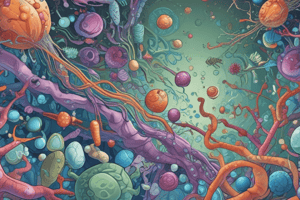Podcast
Questions and Answers
What is the mechanism of action of vancomycin?
What is the mechanism of action of vancomycin?
binds to the terminal end of the growing peptidoglycan to prevent further elongation and cross-linking
Which bacteria are carbapenems powerful against?
Which bacteria are carbapenems powerful against?
- MRSA
- Streptococcus pneumoniae
- Pseudomonas infections (correct)
- Escherichia coli
Aztreonam is resistant to Beta-lactamases.
Aztreonam is resistant to Beta-lactamases.
True (A)
What is the main purpose of empiric therapy when selecting anti-microbial agents?
What is the main purpose of empiric therapy when selecting anti-microbial agents?
Which factor affects the penetration of drugs to the Central Nervous System through the Blood-Brain Barrier?
Which factor affects the penetration of drugs to the Central Nervous System through the Blood-Brain Barrier?
Penicillins inhibit bacterial growth by preventing the cross-linking of peptidoglycan polymers.
Penicillins inhibit bacterial growth by preventing the cross-linking of peptidoglycan polymers.
The _____________ of beta-lactam ring is required for the antibacterial activity of penicillins.
The _____________ of beta-lactam ring is required for the antibacterial activity of penicillins.
What type of bacteria are synthetic penicillins useful for treating?
What type of bacteria are synthetic penicillins useful for treating?
What is the major cause of resistance to penicillins?
What is the major cause of resistance to penicillins?
Which component irreversibly inhibits beta-lactamase and is used in combination products with penicillins?
Which component irreversibly inhibits beta-lactamase and is used in combination products with penicillins?
Cephalosporins have the same mechanism of action as penicillins.
Cephalosporins have the same mechanism of action as penicillins.
Synthitc pencilin are inactivated by ________.
Synthitc pencilin are inactivated by ________.
Match the following cephalosporin generations with their typical uses:
Match the following cephalosporin generations with their typical uses:
Flashcards are hidden until you start studying
Study Notes
Selection of Antimicrobial Agents
- Defining the organism: Culture, Detection of antigens, PCR, Detection of microbial DNA or RNA, Detection of immune response
Empiric Therapy
- In critically ill patients: Use broad-spectrum antimicrobial agents
- In settings where it is hard to get a sensitivity test: Use antimicrobial agents that are usually effective in such situations
Prophylaxis Therapy
- Prevent rather than treat an infection
- Directed against the most likely organism
- Examples of situations:
- Pharingitis: Rheumatic heart disease
- Endocarditis: GABHS
- Before dental extraction: GABHS
- Tuberculosis in contact
- Pre-surgery (GI, urinary sys): Infection afterward gram -ve rods
- Anti-HIV: Prevents transmission
About the Anti-Microbial Agent
- Bacteriostatic vs. Bactericidal: Division is important
- Penetration to the site of infection: Lipid solubility, Molecular weight, Binding to plasma proteins
- Efficacy: Dose, Route of administration, Duration of treatment
- Safety: Less side effects
About the Patient
- Immune status: HIV, DM, Immunosuppressants, Alcohol, etc.
- Antagonistic effect: Bacterecidal + Bacteriostatic
Resistance to Antimicrobial Agents
- Inherited Resistance
- Acquired Resistance: Genetic alterations, Decreased accumulation, Enzymatic inactivation
Complications of Antimicrobial Agents
- Hypersensitivity: Simple hives to anaphylaxis
- Direct toxicity
- Superinfection
Classification of Antimicrobial Agents
- Inhibitors of bacterial cell wall biosynthesis
- Inhibitors of bacterial protein synthesis
- Inhibitors of bacterial metabolism
- Inhibitors of bacterial nucleic acid synthesis
- Inhibit cell membrane function
Inhibitors of Bacterial Cell Wall Biosynthesis
- Penicillins
- Natural penicillins (G, V)
- Synthetic penicillins:
- Antistaphylococcal (penicillinase resistant)
- Extended spectrum
- Antipseudomonal
- Cephalosporins
- Carbapenemes
- Monobactams
- Others: Vancomycin
Beta-Lactam Ring
- Unstable: Degraded by beta-lactamase
- Inactivation: Penicillin-binding proteins (PBPs) involved in cell wall synthesis
Inhibitors of Bacterial Cell Wall Biosynthesis (Continued)
- Mechanism of action: Bind to, and inactivate, penicillin-binding proteins (PBPs) involved in cell wall synthesis
- Spectrum: Gram-positive bacteria with thick external cell walls are particularly susceptible
- Absorption: Rapidly absorbed after enteral administration
- Penetrate the cerebrospinal fluid (CSF) and ocular fluid to a significant extent during inflammation
Natural Penicillins
- Penicillin G: Mainly used to treat infections with the following organisms:
- Gram-positive cocci: Pneumococci (Streptococcus pneumoniae), streptococci
- Gram-positive rods: Bacillus species (B. anthracis)
- Gram-negative cocci: Gonococci and meningococci
- Anaerobes: Most, except Bacteroides fragilis
- Other: Treponema pallidum (syphilis) and Leptospira spp
Synthetic Penicillins
- Penicillinase-resistant penicillins:
- Oxacillin
- Dicloxacillin
- Methicillin
- Nafcillin
- Extended-spectrum penicillins:
- Ampicillin
- Amoxicillin
- Anti-pseudomonas agents:
- Piperacillin
- Ticarcillin
Beta-Lactamase Inhibitors
- Clavulanic acid
- Sulbactam
- Tazobactam
- Used in combination products: Amoxicillin/clavulanic acid (Augmentin), Ticarcillin/clavulanic acid (Timentin)
Cephalosporins
- Structure and mechanism of action: Similar to penicillins
- Pharmacokinetic properties: Widely distributed in body fluids, some penetrate the CSF
- Categorized by antibacterial spectrum: First-generation, Second-generation, Third-generation, Fourth-generation
- First-generation cephalosporins:
- Cephalexin
- Cefazolin
- Cefadroxil
- Uses: Urinary tract infections, Prophylactic in various surgical procedures### Cephalosporins
- Second-generation cephalosporins:
- Include: Cefoxitin, Cefuroxime, Cefotetan, and Cefaclor
- Have a broader spectrum of activity than first-generation drugs
- Used to treat streptococcal infections, H. influenzae, Enterobacter aerogens, Nisseria, Proteus, E. coli, and Klebsiella (HENPECK)
- Decreased activity against gram-positive bacteria (S. epidermidis not covered)
- Uses of second-generation cephalosporins:
- Urinary tract infections (E. coli)
- Respiratory tract infections
- Bone and soft-tissue infections
- Prophylactically in various surgical procedures
- Have been largely replaced by third-generation agents
- Except for cefuroxime, these agents do not penetrate the CSF
Third-generation cephalosporins
- Include:
- Cefdinir (oral)
- Cefixime (oral)
- Cefotaxime (Claforan IV)
- Ceftizoxime (IV)
- Cefoperazone (IV)
- Ceftazidime (Fortum IV)
- Ceftriaxone (Rocephin IV)
- Characteristics:
- Enhanced activity against gram-negative organisms
- Active against H. influenzae, N. gonorrhoeae, N. meningitides, Enterobacter, Salmonella, indole-positive Proteus, and E. coli
- Moderate activity against anaerobes
- Sensitive to cephalosporinase (a β-lactamase)
- Uses of third-generation cephalosporins:
- Empiric therapy for community-acquired meningitis
- Sexually transmitted infections caused by N. gonorrhoeae
- Serious hospital-acquired gram-negative infections, alone or in combination with an aminoglycoside
Fourth-generation cephalosporins
- Cefepime:
- Given IV
- Has powerful coverage against Pseudomonas spp, gram-negative bacteria, and gram-positive staph and strep
Fifth-generation cephalosporins
- Ceftaroline:
- Given IV
- Used to treat community-acquired bacterial pneumonia (CABP) and acute bacterial skin and skin structure infections (ABSSSI)
Adverse effects and drug interactions
- Cephalosporins:
- May cause hypersensitivity reactions (2-5%)
- 5-10% of penicillin-sensitive individuals are also hypersensitive to cephalosporins
- Ceftriaxone:
- May cause bleeding disorders, which can be prevented by vitamin K administration
- Nephrotoxic when administered with diuretics
- All cephalosporins are eliminated by the kidney (except ceftriaxone), and dose adjustment should be considered in patients with renal insufficiency
- May cause superinfection with gram-positive organisms or fungi
- Carbapenems:
- Relatively resistant to β-lactamases
- Demonstrate no cross-resistance with other antibiotics
- Useful for infections caused by penicillinase-producing S. aureus, E. coli, Klebsiella spp., Enterobacter spp., and H. influenzae
- Can cause nausea, vomiting, diarrhea, and skin rashes, and at higher doses, seizures (particularly for imipenem)
Monobactam
- Aztreonam:
- Lacks the thiazolidine ring, making it highly resistant to β-lactamases
- Has good activity against gram-negative organisms
- Lacks activity against anaerobes and gram-positive organisms
- Useful for various infections caused by E. coli, P. aeruginosa, and Enterobacter spp.
- Has no cross-reactivity with penicillins or cephalosporins for hypersensitivity reactions
Other inhibitors of bacterial cell wall biosynthesis
- Vancomycin:
- Mechanism of action: binds to the terminal end of the growing peptidoglycan to prevent further elongation and cross-linking
- Active against gram-positive organisms
- Resistant strains have been reported
- Used to prevent infection with MRSA in patients undergoing prosthetic implantation, and for patients allergic to penicillins and cephalosporins
- Penetrates CSF only during inflammation
- Side effects: fever, chills, flushing, and phlebitis
- Daptomycin:
- Binds to and depolarizes the cell membrane, resulting in loss of membrane potential and rapid cell death
- Has antibacterial actions similar to those of vancomycin
- Active against MRSA and vancomycin-resistant enterococci (VRE)
- Used for complicated skin infections and endocarditis
- Inactivated by lung surfactant; never used in pneumonia
- Telavancin:
- Derivative of vancomycin
- Mechanism of action: similar to vancomycin (cell wall) + disruption of cell membrane (similar to daptomycin)
- Used to treat complicated skin infections caused by resistant gram-positive organisms
- Not active against vancomycin-resistant enterococci (VRE)
- Side effects: metallic taste, N/V, insomnia, headache, and foamy urine
Studying That Suits You
Use AI to generate personalized quizzes and flashcards to suit your learning preferences.




